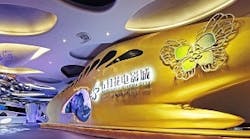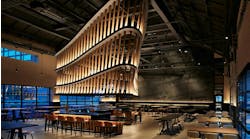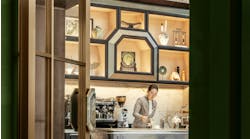Going to the movies can be a generic experience these days—a fact that should disappoint true lovers of cinema. Gone are the days of the freestanding theatre, with its intimate settings and beautifully buttered popcorn; today belongs to the multiplex, a lumbering mammoth of a building designed to deliver maximum entertainment in room after room, row after row. It’s movie-going, stripped of its magic and excitement. Buy your snack, sit, watch, leave.
That’s unless, of course, you go to the movies in a cinema designed by Alexander Wong. An award-winning architect and writer based in Hong Kong, Wong and his eponymous firm specialize in creating avante-garde movie experiences designed to revive our love of seeing movies together. His six “avante-garde cinemas" in China and Hong Kong are marked by their bold colors, dramatic lighting, and outsized dimensions.
"It’s a collective experience,” Wong says, describing both design and cinema's role in Chinese culture. “There’s peer pressure for the younger generation to watch films in cinemas with their friends. It’s a sociological phenomenon.” Likewise, he notes, American mall culture has been around for a long time, “but in China, it’s still a recent thing. You can do everything in a mall: shop, eat and see a movie. It’s important from an economic point of view.”
“The West has a lot of fantasies about China because it’s very mysterious and complicated and ancient,” he adds. “When most people think of China, they think of Mulan, Kung-Fu and things that have been Disney-fied. But China is not one thing. It’s very diversified and it takes in a lot of different cultures.”
Wong’s latest project is the dynamic Cinema Futura in Zhongshan, China. The structure is located atop the new Palm Rainbow Garden Commercial Center, in the Zhongshan MayFlower Cinema City. With a total area of almost 37,000 square feet, it is, in the architect’s words, “out of this world.”
In a unique cultural crossover, Wong drew from science-fiction films Alien, Tron and Avatar as inspiration for the theater’s “wow factor.” The geometric designs and bold colors and patterns his firm is known for are in full effect, helping to define what Wong calls “China’s first science-fiction cinema.”
“Ultimately, what we design is not just a place to show a film,” he says. “You can go any place to see the same film. We are creating the ambiance and brand of the cinema in a mall, which is the world of brands. We are trying to create a new dynamic in spatial experience.”
Work on Cinema Futura began three and a half years ago, and required the reworking and updating of long stretches of the shopping mall’s structure before Wong and his team could proceed with the tech-heavy interior design. “The actual fitting out took a while, because every part is custom made, making this one of the most complex cinemas we’ve ever done,” he says.
SEE: Alexander Wong's avant-garde cinema at the UA Cityplaza in Hong Kong.
Patrons enter Cinema Futura via the golden Butterfly Pavilion. From there, they step into Plaza Pandora, where Alien inspired the ceiling, walls and large, double-layered spiral columns, called Columns Futura. The column shells are an abstract development of alien claws, designed as a double helix.
The Pandora Box Office and Bar Pandora sell tickets and concessions, while the dark Tron Tunnel features glowing laser lighting on the walls, ceiling, and floor to represent movement on one’s way to the individual cinema rooms: House of Blue Whale, House of Red Earth, House of Amazon and House of Purple Rain. The bright colors and futuristic geometrical patterns were drawn directly from Avatar, as well as from 1970s album covers from progressive rock group, Yes.
“We took classic sci-fi films to create the first sci-fi cinema in China,” Wong says proudly. “Film is such a powerful medium. These classic films are still watched and have become a part of our collective subconscious. Sci-fi movies shape the way we see the future. Interestingly enough, China is now in the ‘space race,’ yet there isn’t one major sci-fi film from China, so why not have a truly sci-fi cinema?”
The Solar Gallery, which brings actual sunlight into the space, connects with the Chromosome X-over, a bridge that leads to the giant-screened Pandora 3-D Cinema. For movie galas and premiers, the Plaza offers the Alien Lounge VIP room and Black Mercury media platform.
Designing Cinema Futura, or any cinema space, takes teamwork, says Wong, because “design is not a single discipline.” His staff is made up of designers, architects, animators, illustrators, and artists. They create three-dimensional renderings—sometimes up to 70 different ones for a single space—as ideas evolve and change shape.
“It’s part of what we call the design journey,” he says. “It’s a process, an arduous process. Design is like crossing a desert. It’s slow and difficult in the middle, but you find your oasis. There you find a better version of that space and what it wants to be. When you reach that oasis, it’s very exciting.”
Elianne Halbersberg is a frequent contributor to Interiors & Sources. She has previously written on modern offices and sustainability.


